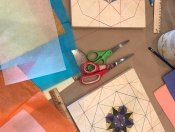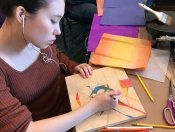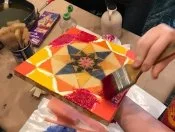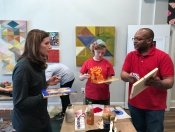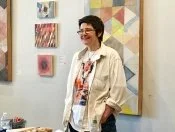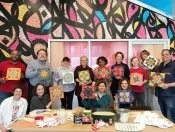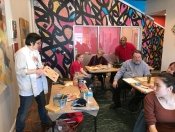Creating Patterns and Beauty Using Encaustic
As part of Tremain Smith’s exhibit at Al-Bustan’s hub, we were pleased to offer an Encaustic Workshop for Adults as the culminating event of our inaugural art exhibition. On Sunday, March 8, 2020 a group of mathematicians, engineers, teachers, artists, and students gathered at Al-Bustan’s hub for a three-hour encaustic workshop. The fourteen participants were guided through the encaustic process, utilizing a mix of techniques borrowed directly from centuries-old encaustic methods and ones created by Smith herself in her own years-long experimentation with this medium. Attendees went home with a finished encaustic piece of their own, learning along the way about Arab and Islamic art, Smith’s art making process, and their own artistic abilities and interests.
While introducing themselves, participants expressed curiosity about and an appreciation for Islamic geometric art, an interest in trying out a new form of art making, a desire to deepen an existing art practice, or to find new energy for a lapsed one. We welcomed a college student who had been studying encaustic and had “become obsessed with it” and saw the flyer for the encaustic workshop while getting a tea next door at Green Line Cafe and “couldn’t believe the serendipity.” One participant, alluding to the life-enriching benefits of art making, told the group:
“I work with numbers and computers all day, and wanted to get a little balance back in my life.”
A mathematician/teacher and an engineer both expressed interest in deepening and putting into practice their love of and interest in math and geometry. Another participant told the group about her desire to “have a meditative, relaxing experience.” As sun streamed through the windows, and we opened the door to let in the warmth of the first sunny day of spring, attendees seemed to embrace the meditative, relaxing nature of the encaustic process.
Smith led the group in first creating six-point rosettes on wooden panels––precise, geometric designs that are recurring motifs in Islamic art and in Smith’s work. While these forms appear mathematically complex and perfect in their symmetry, these shapes can be easily created with a compass and a straight edge, as participants quickly learned. After coloring in these rosette designs with colored pencil, a layer of molten beeswax was brushed onto the panel, seeping into the wood and acting as the first layer of encaustic. Participants chose geometric forms within their designs to highlight, and cut out these shapes out of tissue paper, pressing them into the still-warm beeswax.
Layers of tissue paper were added and adhered into place with a heat gun until participants were ready to add encaustic paint, a mix of oil medium, beeswax, and pigment that Smith makes herself. Each panel was given a border of encaustic paint, after which attendees carved Arabic letters or arabesque flowers into the dried beeswax and brushed the entire panel with oil paint to make the carvings apparent.
Attendees brought with them such joy and enthusiasm in creating their works; the room buzzed with color, movement, and affirmations as participants encouraged each other through the process. In just three hours, attendees created polished, beautiful, and complex works that no doubt inspired a new appreciation for Arab art forms and for art making.
SHUKRAN to all that attended! For more information about Tremain Smith’s work please visit: https://www.tremainsmith.com/
Read recent coverage of Tremain Smith's exhibit at The Maydan

